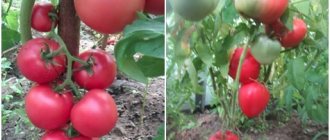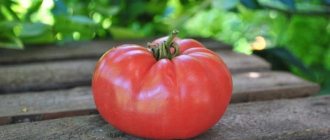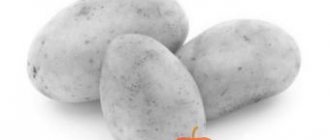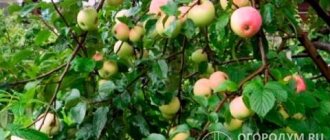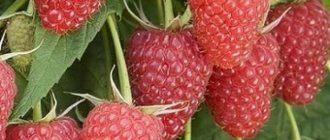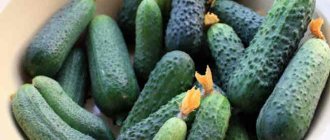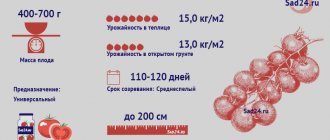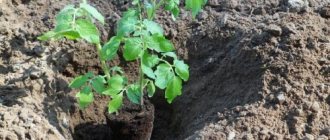Description, photo
A foreign variety of American origin was created by breeders by crossing the Jonathan and Wagner varieties back in 1935.
Due to its productivity, good commercial qualities, and long shelf life, the variety has become widespread not only in the USA, but also in the central and southern regions of Russia, Poland, Belarus, and Ukraine.
It is cultivated in private gardens and in specialized enterprises on an industrial scale.
The Idared apple tree is a vigorous, late-winter variety. The trees develop intensively and begin to bear fruit within a short time after planting.
Abundant fruiting, depending on the type of rootstock, begins after 3-4 years. Fruiting is of mixed type, abundant. The apples are smooth, fairly large, slightly conical . The color of the fruit is light green, almost completely covered with a crimson gloss with numerous fine shading.
Apples Idared.
The peel of apples is thin, but very strong and elastic, and ensures long-term preservation of the pulp. The fruits are harvested at the end of September, and the best consumer ripeness occurs in February.
Tree height
Belongs to tall varieties. Young apple trees grow very quickly and at the age of 10 years reach a height of 3 to 4 m.
Crown width
It has a spherical or slightly oval shape. The main part of the skeletal branches is located at an angle of 45 degrees to the trunk and rushes upward.
Apple tree Idared.
Attention! The tree grows intensively, the crown tends to thicken.
Productivity
The Idared variety is characterized by high yield . Young apple trees aged 6-7 years produce at least 30 kg. Mature plants over 10 years old provide a yield of up to 100 kg of apples each. In industrial gardens, the average yield is 300-400 c/ha or more. Has regular fruiting.
Tasting assessment
Apples have high commercial quality (up to 90%), while up to 15% are of the highest grade, and up to 50% are of the first grade. Taste qualities are rated from 4 to 4.2 points, which corresponds to the average level. It is not aromatic, but contains enough sugars (10.5%) and 0.6 titratable acids. 100 g of dry matter contains 11.5 mg of ascorbic acid.
Idared fruits are of high commercial quality.
Winter hardiness
The root system of the Idared apple tree develops at the soil surface, so the trees do not tolerate low temperatures and have an average level of frost resistance. Exposure to frost has a negative effect on both trees and flower buds.
Important! Regions with mild climates are more suitable for growing this variety.
Resistance to scab and other diseases
The variety is not highly resistant to scab and powdery mildew; rather, it is average or below average.
It has sufficient resistance to brown spot.
In humid, cool summer conditions, a lot of effort and money are required to preserve the commercial qualities of the fruit harvest.
Lifespan of a tree
The lifespan of a tree depends on the type of planting material. Vigorous trees can bear fruit for 30 years or more.
Plants on a dwarf rootstock begin to bear fruit earlier (in the second or third year after planting), but also have a much shorter lifespan - only 10-15 years.
Watch the video of what a four-year-old Idared apple tree looks like:
Diseases and pests
During the growing season, fruit trees are sometimes attacked by insect pests. Also, under suitable weather conditions, various diseases can develop on trees and fruits.
We recommend reading how to get rid of rotting apples.
Common apple tree diseases:
- Scab (Venturia inaequalis) — the cause of the disease is fungal spores overwintering on last year’s leaves lying on the ground. Fungal spores are spread by the wind and their development is facilitated by high air humidity. The Idared apple tree is partially resistant to this disease, but sometimes the tree still gets sick. Symptoms: yellow or discolored spots on the leaves, dark olive spots on the fruit, velvety growths may be present on the underside of the leaves, curling and deformation of the leaves, falling of the leaves from the tree. Control methods: removing and burning fallen leaves in the fall. To speed up the fall of leaves, it may be necessary to add urea and zinc to the soil in September, then sprinkle the fallen and collected leaves with lime. It is also possible to use preparations with fungicides or Bordeaux mixture.
- Black crayfish (Botryosphaeria obtusa) — the development of the disease is provoked by a fungus. The disease appears in the form of chaotically located brown spots with a light center and dark borders on the leaves. On fruit, the disease may appear as purple or brown spots in the center and purple spots around the edges. Fungal spores can overwinter in branches or mummified fruit left on the tree and spread throughout the garden when it rains. How to fight: It is necessary to remove dead or infected wood and dried fruit from trees to reduce the spread of the disease, and burn all wood trimmings. The disease can be controlled by regularly applying fungicides during the period from bud swelling on the apple tree to harvest.
- Apple rust (Gymnosporangium tremelloides Hartig) - a fungal disease accompanied by the appearance of bright orange or yellow spots on the upper side of the leaf blade. The spots are surrounded by a red border along the perimeter; inside the spots the color is black. By mid-summer, a coating of mycelium appears on the surface of the leaves, from which fungal spores are subsequently released. To combat apple tree rust, preparations containing fungicides are used.
- Powdery mildew (Podosphaera leucotricha) - a fungal disease, fungal spores overwinter in the buds of the apple tree. The spread of spores occurs with the help of wind. How to fight: prune infected shoots while they are dormant in early spring, spray with fungicides at the pink bud stage, you can also organically treat the trunk and branches with solutions consisting of water, lime and sulfur.
- Bacterial burn — the cause of the disease is a bacterium that overwinters in the bark or cankers on the trunk and branches. Bacteria are spread by insects, wind and rain. A sick plant looks like it has been damaged by fire. Watery discharge may appear on the bark and branches. What to do: the gardener needs to cut out the diseased wood, treat the trunk and branches with Bordeaux mixture. To prevent the spread of bacterial disease, it may be necessary to spray trees with preparations containing copper or streptomycin during flowering.
Apple tree pests:
- Aphid (Aphis) - leaf-sucking small insects that feed on plant cells. Located on the underside of leaves or on young shoots, they are colored green, yellow or black. Aphids secrete a sticky, sweet substance called honeydew that promotes the growth of sooty mold on plants. What to do: If the aphid population is limited to a few leaves or shoots, the infestation can be reduced by simply removing the infested parts of the plant. You can also wash aphids off the tree with a strong stream of water from a hose. Insecticides are used against aphids if the degree of tree infestation is very high. You can treat the apple tree with a solution of water and insecticidal soap or bitter herbal infusions (wormwood, hot pepper).
- Larvae or caterpillars — appear from the eggs of fruit moths or leaf rollers. You can see the presence of a pest in fruit with the naked eye. This is evidenced by holes in the fruit; the holes may be blocked by crumbly brown tissue (insect excrement) or sealed by a leaf pulled into the hole. The depression in the fruit may be slight or deep, extending to the core of the apple. The larva is a flesh-colored or pink caterpillar with a brown head; its body length can reach 1.3 cm. The intensity of reproduction in these insects is 2–4 generations per year. How to fight: annually lighten the crown by pruning to ensure that insecticides reach all branches, thereby helping to destroy the larvae. Remove weeds in the garden on which insects reproduce without interference, remove infected fruits from trees manually before the larvae leave the fruit. This will help reduce the insect population. Insecticides should also be used.
Reviews
Alexander. “In September, while picking apples in a friend’s garden, I tried Idared. It seemed like some kind of nonsense. But on New Year's holidays I was again treated to the same variety. I was pleasantly surprised. When stored in an ordinary basement, the apples acquired a wonderful taste and were completely preserved. And the harvest from one apple tree lasts for the whole winter. Commendable."
Vladimir. “I spent money on planting material and laid out 1 hectare of garden. I thought for a long time about choosing a variety. I looked at the photo and description of the Idared variety and it attracted me with its shelf life. I was worried whether the costs would be worth it. Already in the third year I reaped a good harvest. And there are no problems with storage.”
Svetlana. “We grafted two buds by budding onto a branch of an old apple tree. The graft quickly took root. And now from this branch we collect beautiful apples for long-term storage.”
Harvest and storage
Idared is a late-winter variety; the fruits reach technical maturity at the end of September or October , at which time the harvest occurs. Apples are stored in a specially equipped room, where the temperature is constantly in the range of +6...+10°C. There the fruits gradually ripen, acquiring a brighter taste and aroma.
The recommended period for consumption of Idared apples is January . Thanks to the dense consistency of apple pulp, the manufacturer can transport the fruit over long distances from the regions where they are grown without loss.
Important! The gardener needs to remember that the apple tree cannot be treated with any chemicals if there are only a few weeks left before the harvest.
Landing
Deadlines
Favorable time for planting seedlings:
- In the spring before the buds begin to bloom;
- In autumn, a month before the onset of frost.
Autumn planting will allow the seedlings to adapt to a new location during the dormant period and begin to grow with the onset of warmer weather.
When planting in spring, it is important not to miss the deadline. Delay will reduce survival rate and require more watering costs. For the middle band, the optimal time is:
- In spring - early April,
- In autumn - late September - early October.
Technology
Work on planting seedlings begins at least a week in advance with the preparation of the planting pit. The size of the hole is 100-120 cm in diameter, and the depth is at least 80 cm and directly depends on the size of the root system.
The roots should be free and not bent. The root collar is located 3-5 cm above the soil level. The top layer of soil mixed with fertilizers and humus is poured into the bottom of the hole. In order to improve air exchange on heavy soils, I add river sand and fine gravel. On light sandy soils, fertility is improved by adding peat and humus.
Attention! Mineral fertilizers must be thoroughly mixed with the soil to prevent direct contact with the roots. Fresh manure is not brought into the pit to avoid burning the root system.
Young seedlings are tied to a wooden stake located on the north side of the tree.
Look at the video about the main secrets of planting apple trees:
Scheme on different rootstocks
Different types of rootstocks provide distinctive tree canopy features. This circumstance is taken into account when planting apple trees. It is necessary to take into account what crown size adult plants will have, so that they grow freely to the sides and do not stretch into the sky. Trees are planted according to the following scheme:
- On a semi-dwarf rootstock - 4.0 x 1.5 m, 4.5 x 2.0 m;
- On a medium-sized rootstock - 4.5 x 2.0 m, 4.5 x 2.5 m;
- On a dwarf rootstock - 4.0 x - 1.0 m, 4.5 x 1.5 m.
Scheme of planting apple trees on different rootstocks.
Vaccinations
The apple tree takes root well on any rootstock. More often, grafting is used in the cleft, behind the bark, or in the side cut. By budding a bud, the variety is grafted onto branches into the crown of old trees.
Watch a video about three methods of vaccination:
Price
The cost of Idared apples depends on the region of sale. The lowest price for them is in the Krasnodar Territory and nearby regions. At the market, apples can be purchased for 40-50 rubles per kilogram . For private farmers this price is even lower.
In areas where the variety is not grown for sale, the price of apples is higher. It starts from 75 rubles per kilogram and reaches 150 rubles for the northern regions. By spring, this figure can be doubled.
Growing
Agricultural technology
Agrotechnical activities include:
- Tilling the soil between rows and tree trunks in order to improve air and water exchange and destroy weeds;
- Watering mature trees during the dry period, as well as young ones after planting, especially in the first year of life.
- Fertilizing with mineral and organic fertilizers: In the first year after planting, no fertilizing is done; the plant will have enough nutrition contained in the planting hole.
- Subsequently, in the spring they are fed with a solution of urea and potassium sulfate.
- Young seedlings are fed with nitrogen fertilizers in spring and autumn and foliar treatments with microelements are carried out.
- , humus, peat or rotted manure are added to the digging
- chemicals: copper sulfate,
- decoctions and infusions of tobacco, wormwood, pepper.
Pruning and crown formation
Pruning and shaping the crown are carried out with the aim of thinning the crown, lowering the height, removing damaged, poorly located branches with signs of disease, and rejuvenating the trees.
Pruning and crown formation of apple trees.
Advice! It is best to prune in early spring.
Removal of damaged branches is carried out throughout the growing season.
Watch detailed video instructions on pruning apple trees:
Care
The Idared apple tree needs nourishment. It responds well to both organic matter and mineral fertilizers .
The best organic complementary food is liquid bird droppings in the form of a concentrate, or rotted livestock manure. This type of fertilizer is introduced in the fall, simply spreading it around the trunk.
An adult tree will require 15 kg of organic matter annually . Bird droppings are diluted with water before being applied to the soil. For one part of fertilizer take 20 parts of liquid.
The Idared apple tree requires watering. If a tree does not have enough water, it will not bear fruit well. Water it in spring, summer and autumn. Every month 25 liters of water are introduced under the tree. If it is young, then 15 liters is enough.
Since the crown of the Idared apple tree is thick, it needs regular pruning. It is performed according to the rules:
- the top of the seedling is trimmed by 15 cm after planting;
- remove branches, except those that are well developed, they will act as second-order branches; pruning according to this principle is performed in the second year of growth of the apple tree;
- the next year, the shoots that appeared on the skeletal branches of the apple tree are cut off - the 3 strongest branches are left, these will be branches of the third order;
- in the 4th year, all ends of third-order branches are cut off by 10 cm, and all remaining growth is removed.
Then pruning is carried out 2 times a year, in the spring and autumn months. In the first half of the year, this procedure is aimed at getting rid of old branches in order to facilitate access to fresh air and sunlight. In autumn, diseased and dry shoots are removed and mummified fruits are removed. Be sure to clean under the tree.
Expert opinion
Chernyaeva Tatyana Dmitrievna
Absolutely loves gardening and grows only organic vegetables
Ask a Question
To prevent the tree from suffering from sunburn and diseases, its trunk is whitened. To prepare the solution you will need 1 kg of lime, 1 bucket of water, 100 g of copper sulfate and 3 kg of clay.
Young apple trees under the age of 3 years must be covered in winter . The roots are protected with spruce branches, straw or sawdust, the crowns are wrapped in agrofibre, the trunk is covered with shield plastic.
Pollinators for this apple tree
All apple varieties, including Idared, are bisexual. This means that the flower has male organs (stamens) and female organs (pistils). To pollinate, insects must transfer pollen from the pistil to the stamens. There it germinates, forming a pollen tube through which sperm move. When they reach the bottom of the pistil, they fertilize the egg that is there. Subsequently, seeds develop from it, and the ovary and fruit develop from the pistil.
In the process of evolution, apple trees have developed a protective mechanism against self-pollination. It is important to ensure genetic diversity of the offspring and the best survival of the species in changing environmental conditions. Pollen from the tree's flowers cannot fertilize the egg. The pestle does not release substances that stimulate germination.
Trees of the same variety are genetically homogeneous, as they are grown vegetatively. Therefore, they can pollinate each other only in rare cases.
About 1.7-2.5% of flowers turn into fruits. If pollination is carried out artificially, you can get a yield of 2.6-7% of flowers.
To get 12-25% of the fruits, it is necessary to plant pollinators of other varieties in the garden. An important condition is the simultaneous flowering of all apple trees.
Best pollinators:
- Starkrimson
- Ruby Dux
- Kuban spur
- James Grieve
- Florina
- Mermaid
- Red Delicious
- Gloucester
- Ruby
- Star King
- Wagner
It is recommended to plant 1 pollinator for every 12-20 trees of the main variety.
Similar varieties
In terms of their external similarity and taste, Idared apples have something in common with such varieties as:
- Kuban Cossack woman . This variety is a daughter form of Idared. It was bred for cultivation in the North Caucasus.
- Jonathan . It is the parent variety for Idared.
- Wagner . Acted as the main variety during breeding.
- Vertical and Tancivia are daughter varieties of Idared, which were obtained in Ukraine.
Agricultural technology
Caring for Idared is no different from growing other fruits in the garden. The main requirements are compliance with regular watering, chemical treatment and loosening.
Watering
A prerequisite for proper care is regular summer watering. Use only water that has been exposed to the sun. An adult Idared tree will need up to 3 buckets of liquid.
Fertilizer
The introduction of nutritional compounds is another mandatory condition for caring for an Idared apple tree. It is advisable to focus on complex dressings. Many gardeners successfully use organic matter - mullein infusion.
Pruning and crown formation
It is recommended to carry out annual pruning, otherwise the tree will grow rapidly and numerous side shoots will appear. It is better to postpone the process to autumn; in spring it is enough to inspect the plant and trim off branches damaged by wind or frost.
Preventive treatment against insects and diseases
Proneness to disease is the main reason for regular treatment of infections. It is recommended to focus on formulations containing copper. The frequency of watering trees is at least three times per season. Chemicals can be used against parasites, but folk remedies can be prepared sparingly, especially before harvest.
Preparing a tree for wintering
Low frost resistance requires annual sheltering of the apple tree. Idared must be wrapped in spruce branches, straw, and burlap. Be sure to cover the root trunk with a thick layer of mulch (peat, compost) or sprinkle spruce branches. In winter, make a high climb through the snow - a snowdrift will serve as excellent protection from frost.
